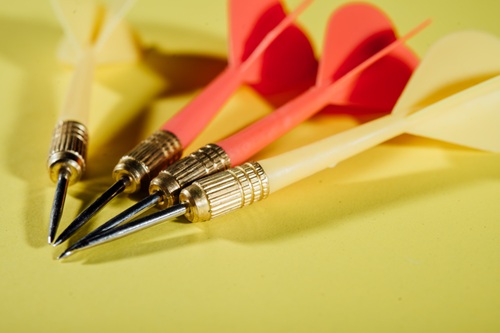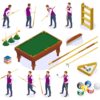If you’ve ever stepped up to the oche and wondered why your throws aren’t landing where you want them to — you’re not alone. Choosing the right dart isn’t just about grabbing the first flashy set you see on the shelf. The right dart can completely transform your game, improving your grip, consistency, and accuracy.
In this beginner-friendly guide, I’ll walk you through exactly how to pick the perfect set, the key differences in materials and styles, and what to look for when testing your new darts. Whether you’re playing for fun at the pub or taking your first steps toward competitive play, this guide will get you sorted.
Understanding the Basics: What Makes Up a Dart
Before you can choose your ideal dart, it’s worth understanding its anatomy. Each part plays a role in how the dart flies and feels in your hand.
| Part | Description | Why It Matters |
| Point | The metal tip that sticks into the dartboard. | Steel tips are for bristle boards; soft tips are for electronic boards. |
| Barrel | The main body where you grip the dart. | Determines weight, balance, and control. |
| Shaft | Connects the barrel to the flight. | Affects the dart’s stability and spin. |
| Flight | The wing-like part at the back. | Influences the dart’s speed and trajectory. |
Step 1: Choose the Right Weight
Darts come in a range of weights, typically between 18 and 30 grams. The best weight depends on your throwing style and comfort.
- Lighter darts (18–22g): Require more throwing force but allow better control. Great for players with a faster throw.
- Heavier darts (24–30g): Travel straighter with less effort but can be harder to control if you have a lighter throw.
Pro Tip: Start with a mid-range weight (around 22–24 grams). Once you’ve practiced a bit, you’ll naturally feel whether you need to go lighter or heavier.
Step 2: Pick a Barrel Material
Barrels are usually made from brass, nickel-silver, or tungsten — and the difference is huge in terms of performance and price.
| Material | Pros | Cons | Best For |
| Brass | Affordable, good for beginners. | Wears down quickly, bulkier. | Casual players |
| Nickel-Silver | Slightly stronger and more balanced. | Still larger than tungsten. | Intermediate players |
| Tungsten | Slim, durable, professional-grade. | More expensive. | Advanced players |
If you’re serious about improving, tungsten darts are worth the investment — they’re slimmer, allowing tighter groupings on the board.
Step 3: Grip Style and Barrel Shape
The barrel’s shape and texture determine how comfortable and stable your grip feels. Here are some common styles:
- Straight barrel: Even thickness; ideal for consistent, balanced throws.
- Tapered barrel: Thicker at one end; helps with precise finger placement.
- Front-weighted barrel: Ideal for players who grip the dart near the front.
Checklist: Finding Your Perfect Grip
☑️ Try different textures — smooth, ringed, or knurled.
☑️ Hold the dart naturally and note any slippage.
☑️ Make 10–15 practice throws before deciding.
Step 4: Choose Shaft Length and Material
Shafts can be short, medium, or long, and they directly affect dart flight.
- Short shafts: Make darts more stable and faster.
- Medium shafts: Balanced — a great place for beginners to start.
- Long shafts: Slower, more arched trajectory; suitable for lofted throws.
As for materials, plastic shafts are lightweight but break easily, while aluminum shafts are more durable and slightly heavier.
Step 5: Flights and Aerodynamics
Flights come in all shapes and sizes — standard, kite, teardrop, slim — each influencing your dart’s behavior mid-air.
- Standard flights: Most popular; stable and forgiving.
- Slim flights: Cut through the air quickly; great for fast, direct throws.
- Kite and teardrop flights: Offer unique balance; experiment to find your match.
Step 6: Test Before You Buy
Whenever possible, test several dart sets before making a purchase. Each combination of weight, barrel, shaft, and flight can feel different.
- Visit a local dart shop or try sets from mates.
- Throw a few practice rounds and notice your accuracy and comfort.
- Record your results — consistency is more important than distance.
If you’re ready to explore top-quality darts and accessories, check out Darts Online for a wide range of beginner-to-pro gear.
Common Mistakes Beginners Make
Avoid these pitfalls that can slow your progress:
❌ Choosing darts based on looks only.
❌ Ignoring the importance of weight distribution.
❌ Using worn-out flights or damaged shafts.
❌ Not testing different styles before committing.
Quick Beginner Checklist
✅ Pick a weight between 22–24g to start.
✅ Choose tungsten barrels if your budget allows.
✅ Use medium-length shafts for balance.
✅ Begin with standard flights.
✅ Practice regularly to build consistency.
FAQs: How to Choose a Dart
How do I know what dart weight suits me best?
Start with 22–24g darts. If your darts drop too soon, try heavier ones; if they fly high, try lighter.
Should beginners buy tungsten darts?
Yes, if you’re committed to improving. Tungsten darts are more precise and long-lasting, making them worth the cost.
How often should I replace my flights and shafts?
Flights should be replaced every few sessions or when frayed. Shafts last longer but should be swapped out if bent or cracked.
Are all dartboards the same?
No — bristle boards are for steel-tip darts, while electronic boards use soft-tip darts. Always match your dart type to your board.
Conclusion
Choosing the perfect dart isn’t just about specs — it’s about feel, comfort, and confidence. Take your time testing different setups, pay attention to how each throw feels, and fine-tune as you go. Once you find that ideal balance, you’ll notice your accuracy and enjoyment skyrocket.




